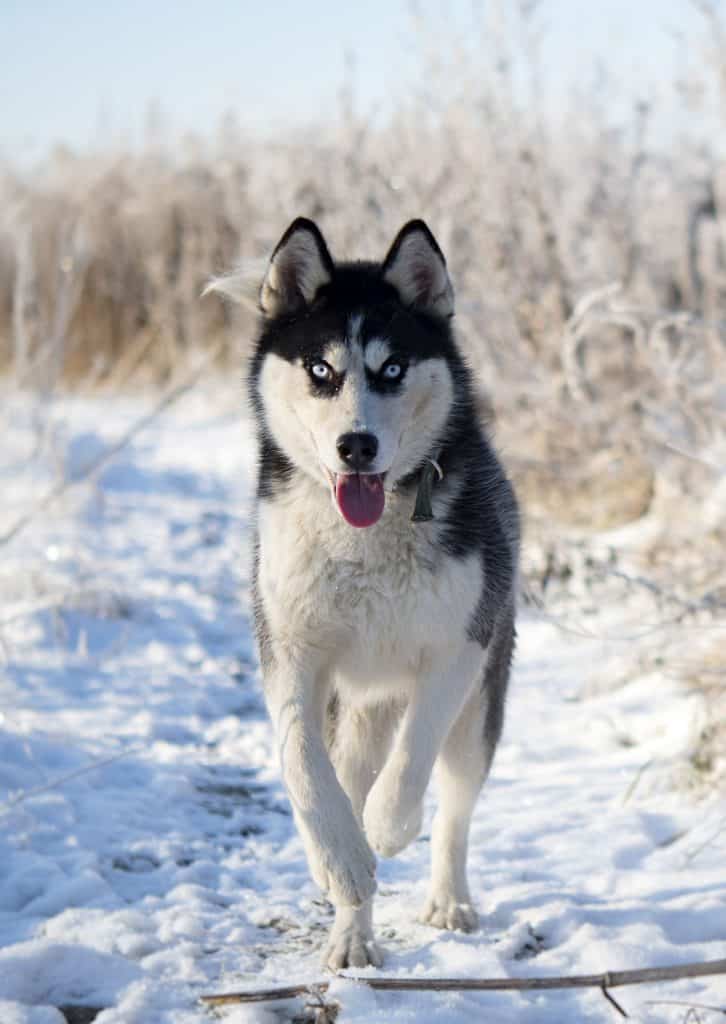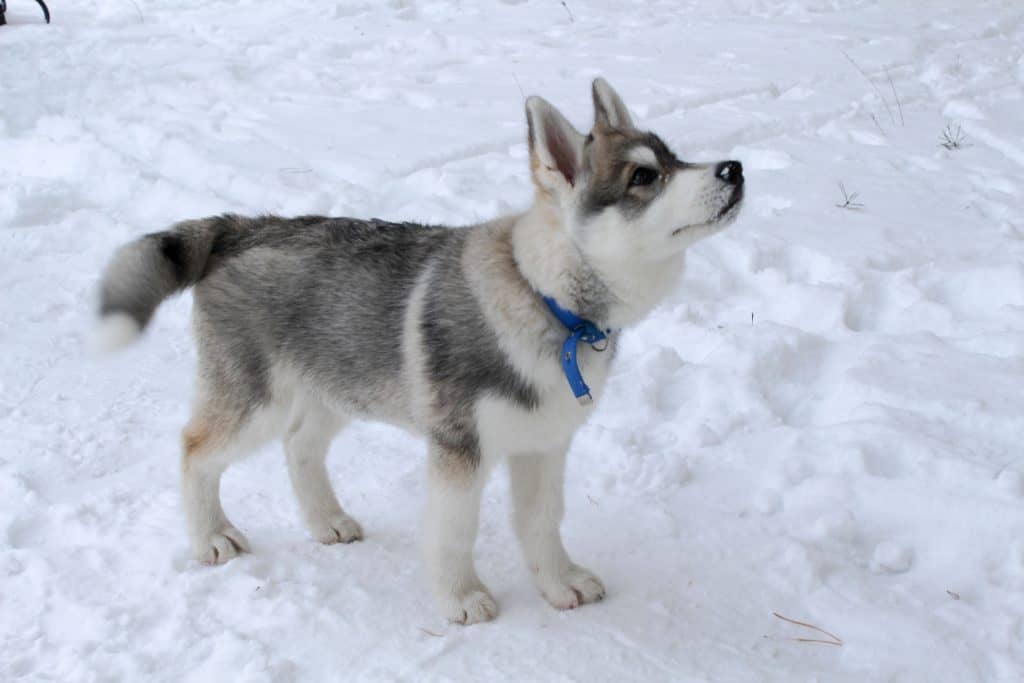Can Huskies Stay Outside in the Cold?

Being outside and playing in the snow during the winter months can be a fun time for you and your husky! Though, it is important to make sure whether your husky can withstand being outside in the cold. I decided to do some research on whether your husky can be outside in the cold and some other information.
Can Huskies stay outside in the cold?
Huskies are bred to withstand cold temperatures. Typically, huskies can be in temperatures as cold as -60 degrees F (-51 degrees C). They often live outdoors but not in the plain snow. They typically sleep in barns or insulated dog homes.
While Huskies can withstand some pretty cold weather, it is still important to know their limits to both the cold and warm weather. Learning how to care for your Husky will give it a more enjoyable lifestyle. Their quality of life will also increase.
The Dangers of Outdoor Temperatures for Your Husky
Cold Weather
We know that Huskies thrive in the cold weather due to the history of their breed. Not only that, but they are built for the brittle, cold weather. They have a dense double-coat that keeps them warm on the coldest of days.
Though, that does not mean that you should leave your Husky out in the cold without a warm place to sleep. Every dog should have a dog house, and this dog house should also be insulated.
If the area you live in has a considerable amount of snow it will be best for your dog if you insulate their little home with hay or straw. It is the best bedding for them since it can be absorbent and warm.
The reason why hay or straw is better than fabric or blankets is that your dog may play in the snow and bring it into their home. That snow will melt and freeze their blankets.
Another important thing to add is that when creating your dogs home you want to make sure it has a door on it. By having a door it can protect from any wind chill and keep the warmth inside their home.
Hot Weather
The coolest part about a Husky is their ability to adapt to almost any climate they live in! That does not mean that as an owner you shouldn’t take special precautions if you are living in a warmer climate with your Husky.
In the summertime, make sure that if you are spending some time outside with your Husky that they have shade and water to help cool them off when needed.
You can even purchase a small plastic pool to fill up with cool water for your Husky to take a dip in if it especially warm that day.
If it so happens to be really warm it is ideal to keep your Husky indoors with the air conditioner on. Do not take them outside for any runs or long walks outside.
The hot weather can make them sluggish and lazy.
An important thing to note: do not shave the coat of your Husky in the summertime.
While it seems logical to shave the coat to help them cool off it is the complete opposite. Shaving the coat of your Husky will make them susceptible to sunburn.
Not only that but their coat helps them regulate their temperature in both hot and cold weather. Taking that away will take away their ability to regulate their own temperature.
Exercise
Huskies are bred to run some pretty long distances and that means that they need a lot of exercise.
With unpredictable weather, that can be difficult to accomplish. For example, in the wintertime, it can be too cold for you to be out in the cold so you may need to bundle up to take your Husky out for a walk in the snow.
In the summertime, you should only walk your dog early in the mornings, or after the sun has gone down. Those times will be the coolest and safest for you to take your dog for a walk.
Make sure to keep an eye out for any signs of overheating and dehydration in your dog during the summer.
If any weather seems to be too much for you or your dog, try playing with them in your basement or a large room in your house to tire them out.
Signs of Overheating and Dehydration
It is important to be able to identify if you dog shows any signs of dehydration or overheating.
Some signs of dehydration in your dog would be dry nose and gums, sunken eyes, and poor skin elasticity. If you want to be able to test your dog’s skin you can pull on the back of their neck.
If the skin does not go back to its normal form, then your dog is likely dehydrated.
Some signs of overheating in your dog would be if they are:
- noisy breathers
- convulsions
- discolored gums
- collapsing
- disoriented behavior
- panting
If you think your dog is showing any of these symptoms you should take them to your local veterinarian as soon as possible. Both conditions are dangerous for dogs to be in and can even lead to their death.
How Cold is Too Cold for Your Dog?

Temperatures
Not all temperatures are the same and that is important to keep in mind when thinking about your pup.
While you may not feel cold, you have to remember that you are covered head to toe in winter gear. While, on the other hand, your dog is covered by its fur.
Wind Chill –The smallest brisk breeze can cut right through your dog’s coat, leaving them cold and unable to regulate their temperature.
Dampness – any form of dampness whether that is rain, wet snow, heavy fog or even taking a dip in a small pond can soak your dog’s coat. This will have them feeling a bit chilly despite the temperature not being cold in the slightest.
Cloud Cover – Cloudy days, even in the summer, can have your dog feeling a bit more chilly than usual. Even if their coat is not as thick as others.
Activity – If your dog is going to be outside running around or playing with other dogs then their body temperature will rise which won’t be a problem if the temperature outside is a bit chilly that day.
Cold Weather Safety for Dogs
Signs That Something Might be Wrong
- Anxiety: Many dogs experience anxiety when they get too cold or if they become fearful.
- Whining or barking: If your dog is not much a “talker” then barking or whining can be an obvious sign for you as an owner that they have had enough. Though if your dog is already a whiner, then you should look for if they are looking you in the eyes as they bark.
- Stop moving: You are out on a walk and your dog stops to lift their paws, look underneath for any balls of snow or ice stuck between them. it may be time to go home if that is the case.
- Shivering: This is one of the most obvious signs that your dog may be cold.
- Looking for safety: If a dog is too cold they will start looking for shelther, whether that be a bush, a spot under a car nearby or just about anything they can fit into to keep warm.
Being Safe With Your Dog in Outside Weather
- The most important thing you can do to keep your dog safe in extreme hot or cold temperatures is to keep an eye on them and pay attention to anything they might do.
- In the wintertime have your dog begin to wear boots and a jacket. This will be a necessity if you take your dog outside for walks. If you decide not to have your dog wear boots, make sure to clean off the de-icer from his paws when you get home.
- If you leave your dog outside during the day or at night, make sure their dog home is insulated in the winter and he has bedding that will keep him warm.
- When fresh snow hits and your first thought is to take your dog outside be sure to look for any crust on the snow. If your dog runs across it, it will cut your dog’s paws or legs.
- If your dog spends a good amount of time outside you need to be sure that the water they have outside with them won’t freeze. You can do this by purchasing a heater to place within his home outside.
Related Questions:
Are Huskies hard to train?
Huskies are known for being one of the most difficult dog breeds to train. This is because they are a pack dog, which means that you should not treat them as your equal. If you do, they are not as likely to follow your commands.
What temperature can Huskies tolerate?
Huskies can live in temperatures as low as -70 degrees F. Though you will want to make sure that they have an insulated dog house that they can sleep in during the night. Huskies can also tolerate extremely high temperatures, but do not shave your husky no matter how hot it becomes.
